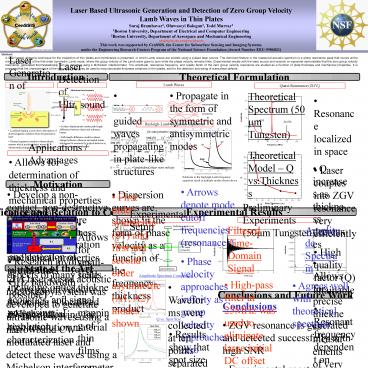Abstract: - PowerPoint PPT Presentation
1 / 1
Title:
Abstract:
Description:
The dominant feature in the measured acoustic ... Experimental results with the laser source and receiver on epicenter demonstrate ... 2. Hutchins, D.A. ... – PowerPoint PPT presentation
Number of Views:42
Avg rating:3.0/5.0
Title: Abstract:
1
Laser Based Ultrasonic Generation and Detection
of Zero Group Velocity Lamb Waves in Thin Plates
Suraj Bramhavar1, Oluwaseyi Balogun2, Todd
Murray21Boston University, Department of
Electrical and Computer Engineering 2Boston
University, Department of Aerospace and
Mechanical Engineeringsuraj10_at_bu.edu,
twmurray_at_bu.edu This work was supported by
CenSSIS, the Center for Subsurface Sensing and
Imaging Systems,under the Engineering Research
Centers Program of the National Science
Foundation (Award Number EEC-9986821)
Abstract A laser based ultrasonic technique
for the inspection of thin plates and membranes
is presented, in which Lamb waves are excited
using a pulsed laser source. The dominant feature
in the measured acoustic spectrum is a sharp
resonance peak that occurs at the minimum
frequency of the first-order symmetric Lamb mode,
where the group velocity of the Lamb wave goes to
zero while the phase velocity remains finite.
Experimental results with the laser source and
receiver on epicenter demonstrate that the zero
group velocity resonance, generated
thermoelastically, can be detected using a
Michelson interferometer. The amplitude,
resonance frequency, and quality factor of the
zero group velocity resonance are studied as a
function of plate thickness and mechanical
properties. It is proposed that the
characteristics of the resonance peak may be used
to map nanoscale thickness variations in thin
plates, and for the detection and sizing of
subsurface defects.
Introduction
Theoretical Formulation
Lamb Waves
Laser Generation of Ultrasound
Quasi-Resonance (ZGVr)
Laser Detection of Ultrasound
Michelson Interferometer
- Dispersive guided waves propagating in
plate-like structures
- Propagate in the form of symmetric and
antisymmetric modes
Theoretical Spectrum (50 µm Tungsten)
- Resonance localized in space
- Laser couples into ZGV resonance very
efficiently - High quality factor (Q) attainable
- Resonant frequency dependent on thickness
- Changes in thickness of the sample results in
shift of resonance peak
antisymmetric
symmetric
Rayleigh-Lamb Frequency Equations
- Surface displacement creates path length
difference between object and reference beams - Path length difference results in phase change
between reference and signal beams which can be
measured by a photodetector in the form of
intensity changes
- Localized heating occurs due to absorption of
electromagnetic radiation from the generation
laser - Thermal expansion results in thermoelastic
stresses which produce elastic waves
(ultrasound) propagating through the material
Theoretical Model Q vs.Thickness
Applications / Advantages
- Allows for determination of thickness and
mechanical properties of materials - Allows for high bandwidth generation and
detection of ultrasound (over GHz bandwidth
possible) - High spatial resolution
- Q increases as thickness decreases
- Allows for precise thickness measurements of
very thin plates
- Dispersion curves are shown in the form of phase
velocity as a function of the frequency-thickness
product
Solutions to the Rayleigh-Lamb frequency
equations result in multiple modes shown above
Motivation
- Arrows denote mode cutoff frequencies
(resonances) - Phase velocity approaches infinity as group
velocity approaches zero
- Develop a non-contact, non-destructive method to
measure small-scale thickness variations and
mechanical properties in thin films - Zero group velocity resonance is localized in
space allowing for high resolution material
characterization
- First order symmetric (S1) and first and second
order asymmetric (A1, A2) modes shown
Significance and Relation to CenSSIS
Experimental Results
- Allows for small-scale thickness mapping of thin
films - High sensitivity and high resolution may create
possibility for use as small-scale chemical or
biological sensor
Preliminary Experiments (50µm Tungsten)
Experimental Setup
Filtered Time-Domain Signal
Amplitude Spectrum
Pulse Energy 10.2 uJ Pulsewidth 610 ps Rep.
Rate 5.6 kHz
Reference mirror on piezoelectric mount
Generation Laser (1064nm)
sample
Detection 532nm CW Laser (120mW)
lens
- Research involves aspects of many fields
including optics, acoustics, and signal
processing
lens
State of the Art
photodetector
- A laser-based acoustic microscopy system was
developed to generate ultrasonic waves using a
narrowband CW-modulated laser and detect these
waves using a Michelson interferometer. 1 - A method was developed using lasers to generate
and detect Lamb waves in thin materials in an
effort to obtain thickness and elastic property
measurements simultaneously. 2 - A zero group velocity resonance was found that
allowed for very efficient transmission of sound
waves through plates. 3 - Laser-based photoacoustic methods were used for
in vivo imaging of rat brains.4 - References
- 1. Murray, T.W., Balogun, O.,
High-sensitivity laser-based acoustic microscopy
using a modulated excitation source, Applied
Physics Letters, 85(14), 2974-2976, (2004). - 2. Hutchins, D.A., Lundgren, K., Palmer,
S.B., A laser study of transient Lamb waves in
thin materials, J.Acoust. Soc. Am., 85(4),
1441-1448, (1989). - 3. Chimenti, D.E., Holland, S.D.,
Air-coupled acoustic imaging with
zero-group-velocity Lamb modes, Applied Physics
Letters, 83(13), 2704-2706, (2003). - 4. Wang, X., Pang, W., Ku, G., Xie, X.,
Stoica, G., Wang, L., Non-invasive laser-induced
photoacoustic tomography for structural and
functional in vivo imaging of the brain, Nature
Biotechnology, 21(7), 803-806, (2003).
Amplitude Spectrum Comparison
- High-pass filter at 25MHz was used to eliminate
large initial DC offset
- Agrees well with theoretical spectrum
- Waveforms were collected at ten points separated
by 1µm on each sample - Resonant frequency shifts as sample thickness
changes - Q increases as sample thickness decreases
Conclusions and Future Work
- Conclusions
- ZGV resonance is generated and detected
successfully with high SNR - Experimental spectrum shows agreement with
theoretical spectrum - Observed shift of ZGV resonance with thickness
change - Future Work
- Exploration of other factors that may affect Q
(power density, surface roughness, grain-boundary
scattering) - High resolution mapping of materials with
varying thickness - Measurement of resonant peaks at higher
frequencies (up to 600MHz) - Possible use for nanoscale biological or
chemical sensor
Q vs. Spot Size
- Results show that spot size has negligible
effect on Q - Signal-to-Noise ratio increases as spot size
decreases - Similar pattern was seen in 50µm tungsten sample































